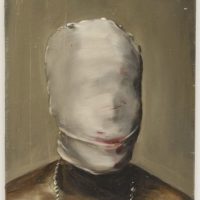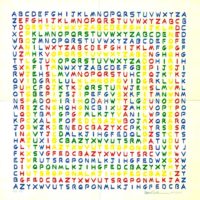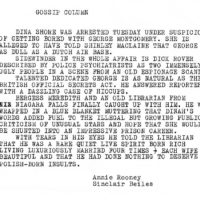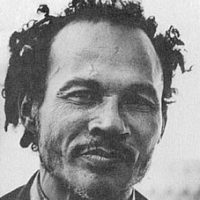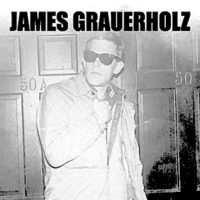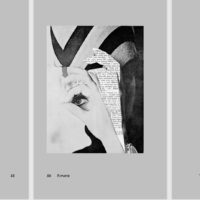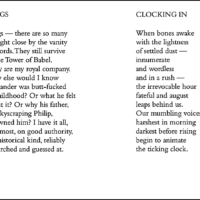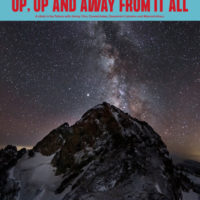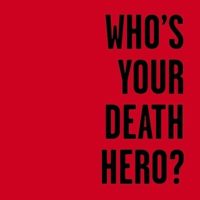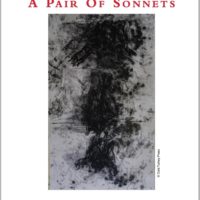Shakespeare’s writing—all of it, poetry and plays—was repulsive to Tolstoy, who claimed that whenever he read Shakespeare he was overcome by “repulsion, weariness, and bewilderment.” As for “King Lear,” ranked among Shakespeare’s four greatest tragedies, he found it “at every step,” according to George Orwell, “stupid, verbose, unnatural, unintelligible, bombastic, vulgar, tedious and full of incredible events, ‘wild ravings,’ ‘mirthless jokes,’ anachronisms, irrelevancies, obscenities, worn-out stage conventions and other faults both moral and aesthetic.”
When Emmett Williams Squared the Alphabet . . .
In 1956, his color scheme was as bright as day. In the plague year of 2020 a color inversion is like the night.
Hedda Hopper Could Have Used This Item
Dina Shore was arrested Tuesday under suspicion of getting bored with George Montgomery. She is alleged to have told Shirley MacLaine that George is as dull as a Dutch air base.
Bob Kaufman: ‘Tin Pan Alley’
“No one has ever written a song about Coronary Thrombosis, / Even though its blessings have been widely recognized . . . / Even though it has saved many people from a lifetime of sorrow . . . / Even though it has rescued many people from bottomless pits of Death . . . / Even though it has provided a good life for millions of doctors, nurses, / Ambulance drivers, morticians, stonecutters and countless others. / Yet, on ungrateful Tin Pan Alley / No one has ever written a song about Coronary Thrombosis.”
GC CUNY at the Center of the Conversation
CHANGE: How Artists Lead the Way
Wednesday, Oct. 21, 7:30 p.m. A FREE ONE EVENT Featuring Vijay Gupta, violinist, founder of Street Symphony, a MacArthur Award-winner, and popular TED speaker; Hồng-An Trương, an artist using photography, sound, video, and performance, whose work has been shown at venues including the International Center for Photography, The Kitchen, and the Museum of Modern Art; and Hank Willis Thomas, a conceptual artist whose work has been exhibited at the International Center of Photography; Guggenheim Museum Bilbao, Spain; and Hong Kong Arts Centre; and who collaborates on the artist-run initiatives for civic engagement For Freedoms and the Wide Awakes. This cross-disciplinary panel will be moderated by Sarah Lewis, associate professor at Harvard University; a leading commentator on race, contemporary art, and culture; and a much-viewed TED speaker.
Homer’s ‘Odyssey’ Comes Alive in London Reading
‘The Odyssey’ tells of the adventures of Odysseus as he tries to get home after the Trojan War, and of his wife Penelope’s struggles to keep their island kingdom from civil war, along with his son Telemachus’ search to find his lost father. This reading brings 72 actors together to perform the epic poem in sequence. ‘The Odyssey’ was first performed by bards across the Mediterranean in the eighth century BCE. The entire reading will remain on YouTube for a week.
Last Words: The Final Journals of William S. Burroughs
In a Wake Island Broadcast James Grauerholz speaks to Paul Kwiatkowski. Wake Island is a conversation series exploring tone, atmosphere, and aesthetics.
‘Algorithms Will Be the Death of Us All’
So said a friend. To which I add two deformed sonnets and a collage.
Chomsky on Trump, Covid-19, Biden, Guns,
the Green New Deal, Putin, the Election . . .
‘Trump will destroy us if he wins…. Whatever you make of the Democratic Party, the White House malignancy is incomparably worse.’ Yes, he’s on RT . . . that RT . . . but what he says is worth every pixel:
Last Night’s Shitshow ‘Debate’ Reminded Me . . .
of a sonnet that appeared in ‘Your Obituary Is Waiting,’s . . . Here it is, with apologies to circus folks. And here he is … nasty, angry, and dopey.
Fascinating Passages from Fascinating Books
‘He did not believe that men were born good, and he admitted original perversity as an element to be found in the depths of the purest souls—perversity, that evil counsellor who leads a man on to do what is fatal to himself precisely because it is fatal and for the pleasure of acting contrary to law, without other attraction than disobedience, outside of sensuality, profit, or charm. This perversity he believes to be in others as in himself. . . . As much as possible he banished from poetry a too realistic imitation of eloquence, passion, and a too exact truth.’
Cold Turkey Press: ‘Another Pair of Sonnets’
My sonnets don’t usually come in pairs, although looking back on them I can see them being paired sometimes as sequels or cousins. Paradoxically, these two came as a pair because they are so different from each other. The darker mood of the one that came second (“Clocking In”) rebukes the lighter mood of the one that came first (“Kings”). Why I should have objected puzzles me now.
From the Design Department
Cutting Edge: Up, Up and Away Off the Page
The designers of The New York Times Magazine are at it again. Do they think edgy makes sense when their design looks like the cover was badly trimmed? Yes, the headline reads “UP, UP AND AWAY FROM IT ALL.” But if the rationale for the design was to get so far up and away, why take half measures? Why not clip off the name of the magazine entirely? Now have a look at the off-the-page design of the spread complete with layout markups, which introduces the cover story on page 43. My guess is the editors want to persuade us the magazine is spontaneous and improvisatory (as in no longer the Gray Lady of legend, which it actually hasn’t been for many years).The spread works nicely. Much better than the cover. But why are they trying so hard?
Good Question: ‘Who’s Your Death Hero?’
Although Albert Camus does not come up in WHO’S YOUR DEATH HERO? — a conversation between the filmmaker Richard Kern and the writer who goes by the name of Supervert — he would be my candidate in answer to the title. Camus’s declaration, “I want to keep my lucidity to the last and gaze upon my death with all the fullness of my jealousy and horror,” conveys precisely what this book is about as if he’d read it himself.
Nailing It
Kayleigh McEnany (aka Baghdad Bob or Comical Ali) and the Clown King do their thing. White House press secretary: “We will not see diseases like the coronavirus come here.” Trump predicts number of Covid-19 cases in the U.S.: “Gonna be down to close to zero … We’ve done a very good job.”
The Battle Over the Supreme Court
Getting down to brass tacks . . . and brass knuckles.
Cold Turkey Press: ‘A Pair of Sonnets’
‘Both belong to a cycle of nine, mostly written during my stay in the rural Connecticut countryside to escape the Covid-19 pandemic during the Spring and Summer of 2020. Both are addressed to writers I admire. “Last Breath” begins the cycle. It was written while remembering my late friend Carl Weissner, before the pandemic began. “The Way the Lines Break” ends the cycle. It was written toward the end of my stay and is addressed to Théophile Gautier, whose poems and stories I was reading thanks to the suggestion of my friend Gerard Bellaart.’ — JH

